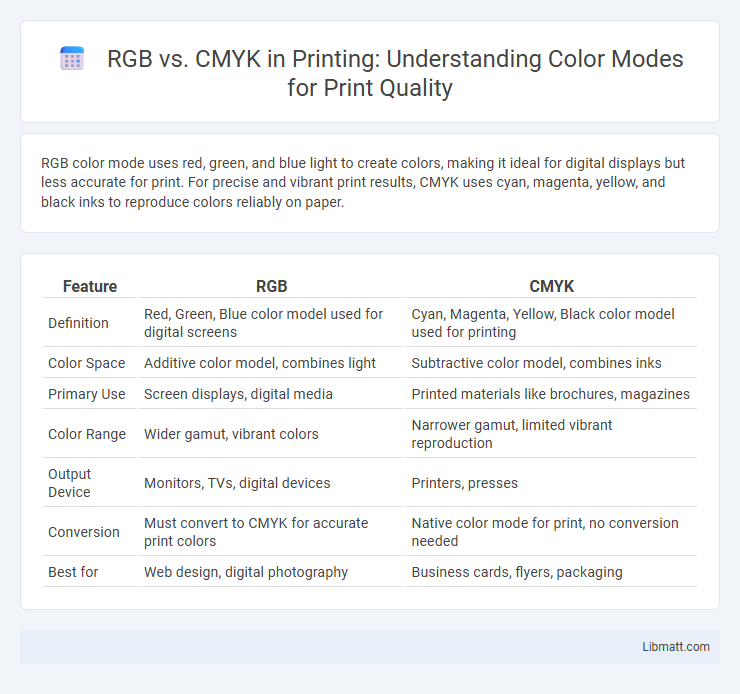RGB color mode uses red, green, and blue light to create colors, making it ideal for digital displays but less accurate for print. For precise and vibrant print results, CMYK uses cyan, magenta, yellow, and black inks to reproduce colors reliably on paper.
Table of Comparison
| Feature | RGB | CMYK |
|---|---|---|
| Definition | Red, Green, Blue color model used for digital screens | Cyan, Magenta, Yellow, Black color model used for printing |
| Color Space | Additive color model, combines light | Subtractive color model, combines inks |
| Primary Use | Screen displays, digital media | Printed materials like brochures, magazines |
| Color Range | Wider gamut, vibrant colors | Narrower gamut, limited vibrant reproduction |
| Output Device | Monitors, TVs, digital devices | Printers, presses |
| Conversion | Must convert to CMYK for accurate print colors | Native color mode for print, no conversion needed |
| Best for | Web design, digital photography | Business cards, flyers, packaging |
Introduction to Color Models in Print
RGB (Red, Green, Blue) is an additive color model primarily used for digital screens, where colors are created by combining light. CMYK (Cyan, Magenta, Yellow, Key/Black) is a subtractive color model essential for print, relying on ink absorption to produce accurate color reproduction on paper. Understanding the differences between RGB and CMYK is crucial for achieving precise color output in the printing process.
What is RGB?
RGB is a color model based on red, green, and blue light, primarily used for digital screens and electronic displays. It creates colors through additive mixing, where combining all three colors at full intensity results in white. Your digital images are often in RGB, but they need conversion to CMYK for accurate color reproduction in print.
What is CMYK?
CMYK is a color model used in printing that combines cyan, magenta, yellow, and key (black) inks to produce a wide range of colors on physical materials. Unlike RGB, which uses light to create colors on screens, CMYK works through ink absorption and layering to achieve precise hues in print. Understanding CMYK is essential for ensuring your designs are accurately represented in printed media.
Key Differences Between RGB and CMYK
RGB uses red, green, and blue light to create colors on digital screens, producing vibrant and luminous visuals, while CMYK relies on cyan, magenta, yellow, and black inks for precise color mixing in printed materials, ensuring accurate color reproduction. RGB color mode operates on additive color theory, combining light to create different colors, whereas CMYK follows subtractive color theory by overlaying inks that absorb light. Understanding these key differences is essential for optimizing your designs for either screen display or print production, preventing color inconsistencies and ensuring the final output meets your expectations.
Why Printers Rely on CMYK
Printers rely on CMYK color model because it uses cyan, magenta, yellow, and black inks to physically reproduce a wide range of colors on paper, matching the subtractive color mixing process inherent in printing. Unlike RGB, which combines red, green, and blue light for digital displays, CMYK inks absorb specific wavelengths, enabling accurate color control and consistency in print outputs. The inclusion of black ink in CMYK enhances depth, detail, and contrast, crucial for professional printing quality across magazines, brochures, and packaging.
Common Issues When Using RGB for Print
Using RGB in print often leads to color inaccuracies since RGB colors are based on light emission and cannot replicate the full spectrum of pigment colors used in CMYK printing. This mismatch causes vibrant RGB hues to appear dull or muted when printed, resulting in unsatisfactory visual outcomes. Converting RGB files to CMYK without proper color management may also cause unexpected shifts and loss of detail in printed materials.
Converting RGB to CMYK: Best Practices
Converting RGB to CMYK requires careful color management to maintain print accuracy, as RGB uses light-based colors while CMYK relies on ink-based colors. Best practices include soft-proofing in design software to simulate CMYK output, using high-resolution images, and adjusting colors manually to prevent dull or muddy prints. You should always consult your printer's specific color profiles to ensure consistent and vibrant results across different printing devices.
Color Accuracy and Consistency in Print
RGB color mode uses red, green, and blue light to create colors on digital screens, but it lacks accurate color reproduction in print due to the limitations of ink-based processes. CMYK, composed of cyan, magenta, yellow, and black inks, provides superior color accuracy and consistency in printed materials by precisely controlling ink densities and overlapping colors. Professional printers rely on CMYK profiles and color management systems to maintain consistent color output across different print jobs and substrates.
Tips for Preparing Print-Ready Files
Ensure all images and graphics are converted to CMYK color mode to match printer requirements and avoid unexpected color shifts. Use high-resolution files, ideally 300 DPI, for crisp and professional print quality. Embed all fonts or outline text to prevent font substitution issues during the printing process.
Conclusion: Choosing the Right Color Mode for Printing
Choosing the right color mode for printing depends on the final output and medium, with CMYK being essential for accurate color reproduction in physical prints due to its subtractive color model and compatibility with ink-based devices. RGB, while vibrant and suitable for digital displays, often results in color discrepancies when converted to print because it uses an additive color model based on light. For precise, consistent print quality, professionals prioritize CMYK to achieve predictable results aligned with industry standards.
RGB vs CMYK (in print context) Infographic

 libmatt.com
libmatt.com